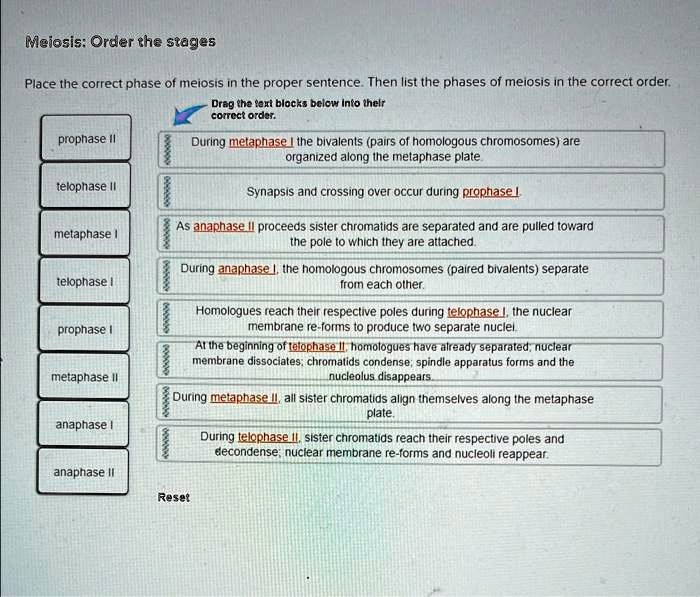Meiosis: Order the stages Place the correct phase of meiosis in the proper sentence. Then list the phases of meiosis in the correct order. Drag the text blocks below into their correct order. prophase II telophase II metaphase I During metaphase I the bivalents (pairs of homologous chromosomes) are organized along the metaphase plate. Synapsis and crossing over occur during prophase I As anaphase II proceeds sister chromatids are separated and are pulled toward the pole to which they are attached. During anaphase I, the homologous chromosomes (paired bivalents) separate from each other. Homologues reach their respective poles during telophase I, the nuclear membrane re-forms to produce two separate nuclei At the beginning of telophase II, homologues have already separated; nuclear membrane dissociates; chromatids condense; spindle apparatus forms and the nucleolus disappears. During metaphase II, all sister chromatids align themselves along the metaphase plate. During telophase II, sister chromatids reach their respective poles and decondense; nuclear membrane re-forms and nucleoli reappear. telophase I prophase I metaphase II anaphase I anaphase II Reset

The Correct Answer and Explanation is:
Correctly Matched Phases and Descriptions
- Metaphase I: During metaphase I the bivalents (pairs of homologous chromosomes) are organized along the metaphase plate.
- Prophase I: Synapsis and crossing over occur during prophase I.
- Anaphase II: As anaphase II proceeds sister chromatids are separated and are pulled toward the pole to which they are attached.
- Anaphase I: During anaphase I, the homologous chromosomes (paired bivalents) separate from each other.
- Telophase I: Homologues reach their respective poles during telophase I, the nuclear membrane re-forms to produce two separate nuclei.
- Prophase II: At the beginning of prophase II, homologues have already separated; nuclear membrane dissociates; chromatids condense; spindle apparatus forms and the nucleolus disappears.
- Metaphase II: During metaphase II, all sister chromatids align themselves along the metaphase plate.
- Telophase II: During telophase II, sister chromatids reach their respective poles and decondense; nuclear membrane re-forms and nucleoli reappear.
Correct Order of Meiosis Stages
- Prophase I
- Metaphase I
- Anaphase I
- Telophase I
- Prophase II
- Metaphase II
- Anaphase II
- Telophase II
Explanation of the Stages
Meiosis is a specialized type of cell division that reduces the chromosome number by half, creating four haploid cells, each genetically distinct from the parent cell and from each other. This process is essential for sexual reproduction and is divided into two major stages: Meiosis I and Meiosis II.
Meiosis I is the reductional division because it separates homologous chromosomes, reducing the chromosome set from diploid to haploid. It begins with Prophase I, a critical stage where homologous chromosomes pair up in a process called synapsis and exchange genetic material through crossing over. This recombination is a primary source of genetic variation. In Metaphase I, these paired homologous chromosomes align at the cell’s center, the metaphase plate. During Anaphase I, the homologous chromosomes are pulled apart to opposite poles, but the sister chromatids remain attached to each other. The first division concludes with Telophase I, where the cell divides to form two haploid cells.
Meiosis II is an equational division, very similar to mitosis, where the sister chromatids are separated. It begins with Prophase II in the two cells from Meiosis I. Here, a new spindle apparatus forms. In Metaphase II, the chromosomes, each still composed of two sister chromatids, line up individually along the metaphase plate. Anaphase II follows, characterized by the separation of these sister chromatids, which are then pulled to opposite poles. Finally, Telophase II completes the process. The chromosomes arrive at the poles and decondense, nuclear envelopes reform, and the cytoplasm divides, resulting in a total of four genetically unique haploid gametes.thumb_upthumb_down
